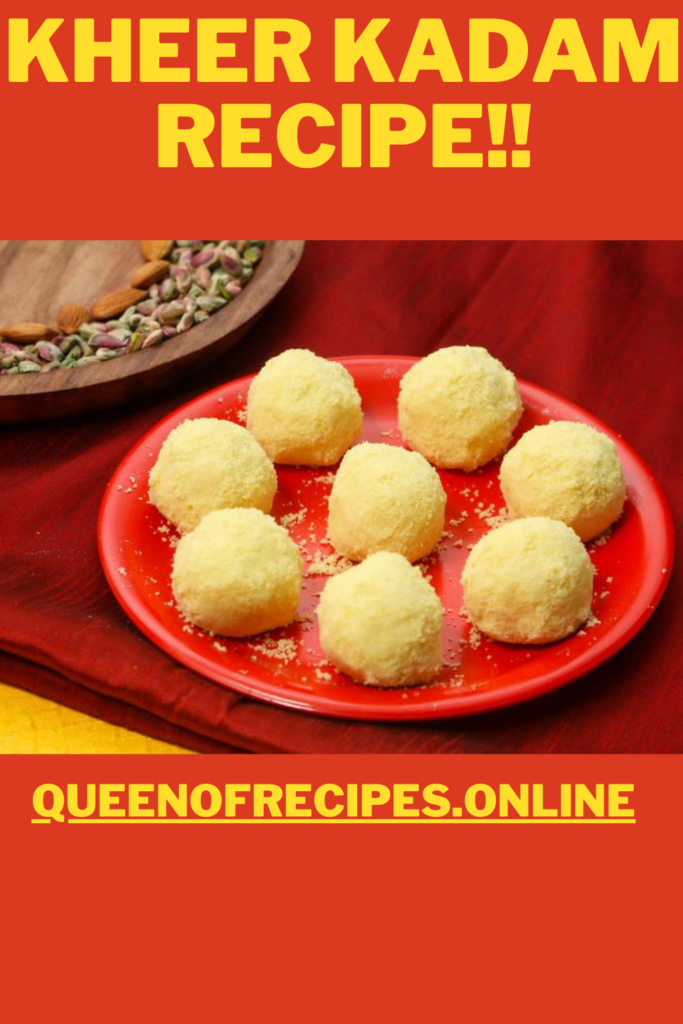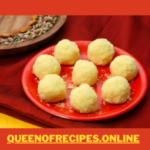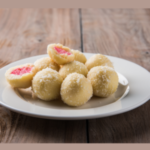Table of Contents
About Kheer Kadam.
Kheer Kadam, also known as Kheer Kodombo or Raskadam, is a delectable Indian sweet that hails from the state of Bengal. This sweet confection is a delightful combination of two layers – an outer layer made from khoya (reduced milk solids) and the inner core featuring a miniature rasgulla (cheese ball soaked in sugar syrup). Encased in a layer of khoya, it offers a harmonious blend of creamy textures and sweet flavors, making it a cherished treat in Bengali cuisine. It is often prepared during festive occasions and celebrations.
Making it involves two main steps: preparing the khoya layer and the rasgulla filling. Here’s a simplified recipe for this delightful Bengali sweet:
Ingredients:
For Rasgulla:
- 1 cup milk
- 1 tablespoon lemon juice or white vinegar
- 1 cup sugar
- 2 cups water
For Khoya Layer:
- 1 cup khoya (reduced milk solids)
- 2 tablespoons powdered sugar (adjust to taste)
- A pinch of cardamom powder
- A few saffron strands (optional)
Instructions:
1. Prepare Rasgulla:
- Heat 1 cup of milk in a pan until it comes to a boil. Add lemon juice or white vinegar to curdle the milk.
- Once the milk curdles, strain the whey using a muslin cloth or a fine sieve.
- Press the chenna (cheese) to remove excess water and knead it until smooth.
- Divide the chenna into small portions and roll them into smooth balls to make rasgullas.
- In a separate pot, combine 1 cup sugar and 2 cups of water. Bring it to a boil to make a sugar syrup.
- Gently drop the rasgulla balls into the boiling sugar syrup. Cover and cook for about 15-20 minutes until they double in size.
- Allow the rasgullas to cool completely.
2. Prepare Khoya Layer:
- Grate or crumble the khoya into a non-stick pan.
- Cook the khoya on low heat, stirring continuously to prevent it from sticking to the bottom.
- Once the khoya starts to melt, add powdered sugar, cardamom powder, and saffron strands (if using). Continue to cook until it forms a smooth, thick consistency.
- Allow the khoya mixture to cool slightly.
3. Assemble Kheer Kadam:
- Take a small portion of the khoya mixture and flatten it in your palm.
- Place a cooled rasgulla in the center and gently encase it with the khoya, shaping it into a round or oval ball.
- Repeat the process for the remaining rasgullas.
- Allow it to set for some time before serving.
Enjoy the delightful combination of creamy khoya and juicy rasgulla in this traditional Bengali sweet!


Nutritional Value.
The nutritional value of it can vary based on specific ingredients and portion sizes. Here’s a general overview of the approximate nutritional content per serving (one piece):
Note: These values are estimates and may vary based on the actual ingredients used in your recipe.
- Calories: Approximately 150-180 calories per piece.
- Protein: 3-4 grams
- Fat: 8-10 grams
- Saturated Fat: 5-6 grams
- Carbohydrates: 15-18 grams
- Sugar: 10-12 grams
- Fiber: 0-1 gram
- Cholesterol: 15-20 milligrams
- Sodium: 30-40 milligrams
These values can be influenced by factors such as the type of khoya used, the amount of sugar, and the size of each Kheer Kadam. To obtain accurate nutritional information, it’s recommended to calculate based on the specific ingredients and quantities you use in your recipe. Additionally, keep in mind that these values are for one serving, and the actual nutritional content may vary based on your portion size and overall diet.
Health Benefits.
Kheer Kadam, a traditional Bengali sweet, offers some health benefits along with its indulgent taste:
- Calcium from Khoya: The khoya (reduced milk solids) used it is a good source of calcium, which is essential for maintaining strong bones and teeth.
- Protein from Rasgulla: The rasgulla filling provides a moderate amount of protein, contributing to muscle repair and overall body function.
- Energy Boost: The combination of khoya and sugar in Kheer Kadam provides a quick source of energy, making it a delightful treat for a sweet indulgence.
- Moderation and Enjoyment: Including traditional sweets in moderation as part of cultural or festive celebrations can contribute to a positive and enjoyable relationship with food.
- Occasional Treat: While it is a delicious treat, it’s best enjoyed occasionally as part of a balanced diet, considering its sugar and fat content.
It’s important to note that, like many traditional sweets, Kheer Kadam is a rich and indulgent dessert. While it can be enjoyed as part of festive occasions, individuals with specific dietary concerns or health conditions should consume such treats in moderation.
Tips and Tricks.
Achieving the perfect Kheer Kadam requires attention to detail and a few tricks. Here are some tips to enhance your Kheer Kadam preparation:
- Quality of Khoya:
- Use fresh and good-quality khoya for a creamy texture and rich flavor. Homemade khoya or store-bought khoya can be used.
- Consistency of Khoya:
- Cook the khoya on low heat to avoid burning and ensure a smooth consistency. Stir continuously to prevent sticking to the pan.
- Flavoring the Khoya:
- Add a pinch of cardamom powder and saffron strands to the khoya for a delightful aroma and flavor. This enhances the overall taste of it.
- Rasgulla Preparation:
- Ensure that the rasgullas are well-cooked and have absorbed the sugar syrup. The rasgullas should be cooled completely before being encased in the khoya layer.
- Balancing Sweetness:
- Adjust the amount of powdered sugar in the khoya to suit your sweetness preferences. Remember that the sweetness of the rasgulla also contributes to the overall taste.
- Shaping the Kheer Kadam:
- When encasing the rasgulla with khoya, work quickly but gently to shape it. It’s important to maintain the individuality of each piece.
- Setting Time:
- Allow the assembled it to set for some time before serving. This helps the khoya layer to firm up, creating a well-defined outer covering.
- Presentation:
- Present Kheer Kadam in small, bite-sized portions for a visually appealing and convenient serving size.
- Storage:
- Store it in an airtight container in the refrigerator. Consume within a few days for the best taste and texture.
- Experiment with Garnishes:
- Garnish the Kheer Kadam with finely chopped nuts like pistachios or almonds for added texture and a decorative touch.
By following these tips, you can master the art of making Kheer Kadam and delight in this traditional Bengali sweet.


Serving Suggestions.
Enhance the presentation and enjoyment of Kheer Kadam with these serving suggestions:
- Garnish with Nuts:
- Sprinkle finely chopped pistachios, almonds, or cashews on top of the Kheer Kadam. This not only adds a delightful crunch but also enhances the visual appeal.
- Rose Petals:
- Garnish the serving plate with fresh and clean rose petals for a touch of elegance and a subtle floral aroma.
- Edible Silver Leaf (Varak):
- Place a small piece of edible silver leaf (varak) on top of each Kheer Kadam for a traditional and festive touch.
- Serve with Rabri:
- Accompany Kheer Kadam with a side of rabri (reduced sweetened milk) to intensify the richness and sweetness of the overall dessert experience.
- Fruit Compote:
- Serve Kheer Kadam with a side of fruit compote or a fruit reduction (such as mango or mixed berry) to introduce a fruity contrast to the creamy sweetness.
- Chai or Coffee Pairing:
- Enjoy Kheer Kadam with a cup of masala chai or aromatic coffee to balance the sweetness with a hint of spiciness or bitterness.
- Individual Plating:
- Plate each Kheer Kadam individually on small, decorative serving plates or dessert bowls for an elegant and personalized presentation.
- Sprinkle with Edible Colors:
- Add a pop of color by lightly dusting the Kheer Kadam with edible colored powders, such as edible gold or silver dust, for a festive appearance.
- Serve in Traditional Bowls:
- Present Kheer Kadam in traditional Bengali bowls or on banana leaves during special occasions for an authentic touch.
- Create a Dessert Platter:
- Arrange Kheer Kadam alongside other Indian sweets to create a diverse and visually appealing dessert platter for celebrations.
Remember to tailor the serving suggestions to the occasion and your preferences and enjoy the rich and delightful experience of savoring Kheer Kadam.
FAQs.
How long does Kheer Kadam stay fresh?




Kheer Kadam typically stays fresh for about 2-3 days when stored properly. To maintain its taste and texture, store it in an airtight container in the refrigerator. After this period, the khoya layer may begin to change in texture, and the overall quality may diminish. For the best experience, it’s recommended to consume Kheer Kadam within the first few days of preparation.
Can I use jaggery instead of sugar?



While traditional Kheer Kadam is made with sugar, you can certainly experiment with using jaggery as a sweetener for a unique flavor profile. Jaggery adds a distinct taste and richness to the dish.
To substitute jaggery for sugar:
Adjust Quantity: The sweetness level of jaggery can vary, so start by adding a smaller amount than the sugar quantity mentioned in the recipe.
Dissolve and Strain: Dissolve the jaggery in water, strain it to remove impurities, and then use the liquid in place of the sugar syrup for the rasgulla.
Balance Flavors: Keep in mind that jaggery has a different flavor compared to sugar, so the final taste of your Kheer Kadam will have a hint of molasses or toffee-like notes.
Experimenting with jaggery can be a delightful twist, providing a more traditional and earthy sweetness to your Kheer Kadam. Adjust the quantity based on your taste preferences.
How to store Kheer Kadam?




To store Kheer Kadam and maintain its freshness, follow these steps:
Cool Completely: Allow the freshly prepared Kheer Kadam to cool completely at room temperature before attempting to store it.
Airtight Container: Transfer the Kheer Kadam to an airtight container. Ensure that the container is clean and dry.
Refrigerate: Store the airtight container in the refrigerator. Refrigeration helps prevent the khoya layer from becoming too soft and maintains the overall texture.
Avoid Strong Odors: Keep the Kheer Kadam away from strong-smelling foods in the refrigerator to prevent it from absorbing unwanted flavors.
Consume Within Days: For the best taste and texture, consume the stored Kheer Kadam within 2-3 days. Over time, the texture may change, and the quality may diminish.
Separation: If you notice any separation or changes in texture after refrigeration, gently reshape the Kheer Kadam before serving.
Proper storage is crucial to maintaining the quality of Kheer Kadam, ensuring that it remains a delightful treat for as long as possible.
What if my khoya layer is too soft?



If your khoya layer in Kheer Kadam is too soft, you can take the following steps to firm it up:
Refrigerate:
Place the assembled Kheer Kadam in the refrigerator for some time. The cold temperature will help the khoya layer firm up.
Chill Before Assembling:
Ensure that the khoya mixture is sufficiently cooled before using it to encase the rasgullas. This can prevent the khoya from being too soft during assembly.
Adjust Khoya Consistency:
When cooking the khoya, ensure that it reaches a thick consistency before removing it from the heat. This will contribute to a firmer khoya layer.
Add Nuts or Binding Agent:
If the khoya remains too soft, you can add finely chopped nuts or a binding agent like powdered biscuits to help give it more structure.
Reassemble:
If the khoya layer becomes too soft after assembling, carefully reshape the Kheer Kadam and place it back in the refrigerator to set.
Remember that achieving the perfect texture in Kheer Kadam may require some experimentation and adjustments based on factors such as the type of khoya used and environmental conditions.
Can I make Kheer Kadam without saffron?




Yes, you can make Kheer Kadam without saffron. Saffron is often used to add a distinct flavor and a golden hue to the khoya layer. If you prefer not to use saffron or don’t have it available, you can still make delicious Kheer Kadam with the following considerations:
Flavor Alternatives:
If you omit saffron, consider enhancing the flavor of the khoya layer with other ingredients like cardamom powder or a touch of rose water for a different aromatic profile.
Color Options:
Without saffron, the khoya layer will not have the characteristic golden color. You can leave it plain or explore natural color alternatives such as a pinch of turmeric for a subtle yellow hue.
Texture Focus:
Concentrate on achieving a smooth and creamy texture in the khoya layer, as saffron primarily contributes to color and a mild flavor.
Feel free to experiment with different flavoring agents to suit your taste preferences and create a version of Kheer Kadam that you find most enjoyable.

